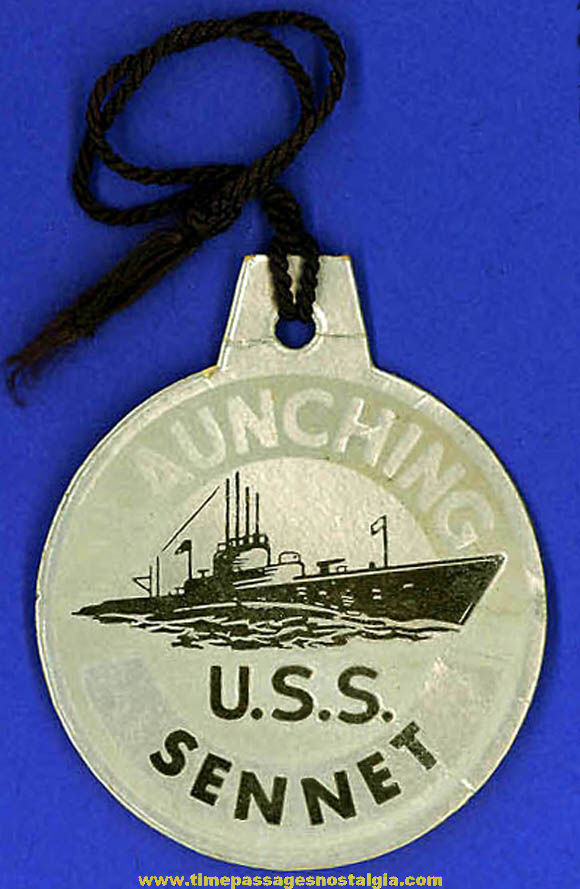
 | Item #m608 | 
Price: $19.99
$6 shipping & handling
For Sale
|
|
  | | Any group of items being offered as a lot must be sold as a lot. | | | | We have an extensive inventory that is not yet on our web site. If there is something you are looking for and did not find, please send us your wish list. | Whether you've collected Memorabilia for years or just want to feel like a kid again, please take a few moments to browse through what we
have available for sale. | Nostalgic Memorabilia, Pop Culture Artifacts, Historic Items,
and "Shoe Box Toys" |  | | Quality Merchandise At Reasonable Prices | You can feel secure
shopping with PayPal. | Quality Packing And
Postal Insurance | | Combined Shipping And Handling |
| | | | The picture below shows a larger view of this 1944 U.S.S. Sennet (SS-408) Submarine Launching Souvenir Tag. This launching badge is believed to have been saved by a Portsmouth Naval Shipyard worker. It was found in Maine with many others dating from 1943 to 1944 when many ships and submarines were built and launched to do battle in World War II. They had been hidden away since the 1940s until 2009. The submarine was launched from The Portsmouth Naval Ship Yard in Kittery, Maine. This cardboard tag has its original black cord attached. It is imprinted in gray and black on a silver background. The back side is identical. It pictures a United States Navy Submarine and it is marked as follows: LAUNCHING
U.S.S. SENNET The tag measures 1-3/4'' wide. It appears to be in excellent condition as pictured. Below here, for reference, is some historical information on the U.S.S. Sennet (SS-408) submarine: U.S.S. Sennet (SS-408)
From Wikipedia, the free encyclopedia History
Builder: Portsmouth Naval Shipyard, Kittery, Maine
Laid down: 8 March 1944
Launched: 6 June 1944
Commissioned: 22 August 1944
Decommissioned: 2 December 1968
Struck: 2 December 1968
Fate: Sold for scrap, 15 June 1973
General characteristics
Class and type: Balao class diesel electric submarine
Displacement: 1,526 tons (1,550 t) surfaced, 2,401 tons (2,440 t) submerged
Length: 311 feet 8 inches (95.00 m)
Beam: 27 feet 3 inches (8.31 m)
Draft: 16 feet 10 inches (5.13 m) maximum
Propulsion: 4 - Fairbanks Morse Model 38D8-⅛ 10 cylinder opposed piston diesel engines driving electrical generators, 2 – 126 cell Sargo batteries, 2 – low speed direct drive Elliott electric motors, two propellers, 5,400 shp (4.0 MW) surfaced, 2,740 shp (2.0 MW) submerged
Speed: 20.25 knots (38 km/h) surfaced, 8.75 knots (16 km/h) submerged
Range: 11,000 nautical miles (20,000 km) surfaced at 10 knots (19 km/h)
Endurance: 48 hours at 2 knots (3.7 km/h) submerged, 75 days on patrol
Test depth: 400 feet (120 m)
Complement: 10 officers, 70 - 71 enlisted
Armament: 10 – 21 inch (533 mm) torpedo tubes, 6 forward, 4 aft, 24 torpedoes, 1 – 5 inch (127 mm) / 25 caliber deck gun, Bofors 40 mm and Oerlikon 20 mm cannonThe U.S.S. Sennet (SS-408) was a Balao class submarine, a ship of the United States Navy named for the sennet, a barracuda. Sennet was laid down on 8 March 1944 by the Portsmouth Navy Yard in Kittery, Maine, launched on 6 June 1944, sponsored by Mrs. Roscoe W. Downs, and commissioned on 22 August 1944, Commander George E. Porter in command. Sennet was fitted out by 18 September. She held training exercises and torpedo tube testing off the coast of Connecticut and Rhode Island until 22 October. The submarine then tested mines and torpedoes for the Mine Warfare Test Station, Solomons Island, Maryland. On 11 November, Sennet proceeded to the operations area off Balboa, C. Z. and conducted further training exercises. The submarine departed Balboa on 29 November for Pearl Harbor and arrived there on 16 December 1944. Sennet's topside armament was increased to two 5 inch (130 mm) guns, two 40 millimeter guns, and three .50 caliber machine guns before departing Pearl Harbor for her first war patrol on 5 January 1945. First and second patrols, January - March 1945
Sennet patrolled north of the Bonin Islands until 28 January. She made two attacks on a large tanker with three escorts on 21 January but scored no hits. The following week, the submarine sank one 500 ton picket boat and damaged another. Sennet refitted at Saipan from 31 January to 7 February, when she began her second war patrol off southern Honshū, Japan. On 13 February, two 300-ton picket boats were sunk by the combined gunfire of Sennet, Haddock (SS-231), and Lagarto (SS-371). Three days later, the submarine attacked enemy minelayer the Nariu with an offset spread of torpedoes from her stern tubes, then went deep to 200 feet (60 m). Two torpedoes were heard to explode. While going deep, Sennet was rocked hard by two aircraft bombs which exploded beneath her. The submarine surfaced an hour later and saw a large oil slick and approximately 40 Japanese clinging to debris but no trace of the Nariu which had sunk. Third and fourth patrols, April - August 1945
Sennet was refitted by Apollo (AS-25) in Apra Harbor, Guam, 9 March - 2 April. Patrolling off Honshū again from 3 April to 16 May, she was twice straddled by torpedoes fired from patrol boats while she was surfaced off Miki Saki on 16 April. Three days later, the submarine torpedoed and sank the cargo ship Hagane Maru. On 22 April, Sennet attempted to save a P-51 pilot who had bailed out near her but the man went under only 100 feet (30 m) from the ship. Attempts to find him were in vain. A repair ship was attacked on 28 April with two electrical torpedoes. The first blew the bow off and the second hit under the mainmast. Hatsushima sank by her stern. On 1 May, Sennett fired five steam torpedoes at an Asashio class destroyer but it maneuvered and avoided them. At the end of this patrol, the submarine sailed to Pearl Harbor for upkeep and leave. Sennet's most profitable patrol was from 1 July to 9 August in the Sea of Japan. During the patrol, she sank one passenger cargo ship, two cargo ships, and one tanker totaling 13,105 tons. 1945 - 1951
When the war ended in the Pacific, Sennet was assigned to the Atlantic Fleet and operated from New London, Connecticut. In June 1946, she was reassigned to Submarine Squadron 6 (SubRon 6) at Balboa, C.Z. From 10 December 1946 to 13 March 1947, Sennet participated in Operation Highjump, the third Byrd Antarctic Expedition. Sennet used the first basic under ice sonar to establish the feasibility of United States under ice operations. Sennet operated from Balboa until 1949 when she was assigned to operate from Key West, Florida, as a unit of Submarine Squadron 12 (SubRon 12). The ship conducted training for submarine and antisubmarine personnel at Key West and Guantanamo Bay, Cuba. In 1951, Sennet was converted to a Fleet Snorkel submarine at the Philadelphia Naval Shipyard and returned to her homeport. 1954 - 1973
On 4 November 1954, Sennet departed Key West on her first deployment to the Mediterranean and service with the 6th Fleet. From her return on 30 January 1955 until 1 August 1959, the submarine conducted training, local, and fleet operations with her squadron. On 1 August, Sennett was reassigned to SubRon 4 and stationed at Charleston, South Carolina. For the next nine years, the submarine operated from Charleston with the Atlantic Fleet. She operated along the east coast, in the Caribbean, and in the Atlantic with her squadron until mid 1968. In November 1968, the submarine was found unfit for further Naval service. Sennet was struck from the Navy list on 2 December 1968. On 18 May 1973, her hulk was sold to Southern Scrap Material Company Ltd., New Orleans, Louisiana. Honors and awards
Sennett received four battle stars for World War II service. |
|
Click on image to zoom.
 |